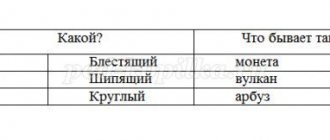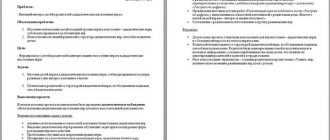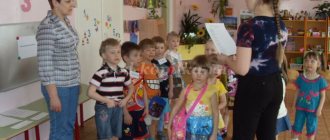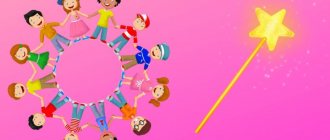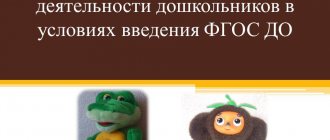Role-playing game as a means of developing imagination in senior preschool age
Pages: 1
Content
- Introduction
- CHAPTER 1. Theoretical foundations for the development of imagination in role-playing games in preschool age
- 1.1. Psychological and pedagogical aspects of imagination development in preschool childhood
- 1.2. Psychological and pedagogical foundations for the development of role-playing play in children of senior preschool age
- Conclusions on Chapter 1
- CHAPTER 2. Study of the peculiarities of the development of imagination and role-playing games of older preschoolers (based on materials from the ascertaining experiment)
- 2.1. Methodology and tasks of the ascertaining experiment
- 2.2. Analysis of the results of the ascertaining experiment
- 2.3. Development and testing of a pedagogical project aimed at developing the imagination of children of senior preschool age in role-playing games
- 2.4. Studying the imagination of children of senior preschool age (based on materials from a control experiment)
- Conclusions on Chapter 2
- Conclusion
- List of used literature
Introduction
Preschool childhood is the age of primary socialization of the individual, the initial formation of the child’s personality (L. S. Vygotsky, A. N. Ananyev, A. A. Venger, etc.).
During these years, the child acquires initial knowledge about the life around him, he begins to form certain attitudes towards people, towards the phenomena of the surrounding reality, his character develops (A.V. Zaporozhets, D.B. Elkonin, S.L. Rubinstein, etc.)
The federal state educational standard states that the standard was developed on the basis of the Constitution of the Russian Federation and the legislation of the Russian Federation and taking into account the UN Convention on the Rights of the Child, which is based on the basic principle:
“implementation of the Program in forms specific to children of a given age group, primarily in the form of play, cognitive and research activities, in the form of creative activity that ensures the artistic and aesthetic development of the child.”
Particular attention in the development of preschool children within the framework of the Federal State Educational Standard of Preschool Education is paid to five main areas:
- social and communicative development;
- cognitive development;
- artistic and aesthetic development;
- speech development;
- physical development.
In this regard, a contradiction arises:
- Between the requirements imposed by society and the state on the level of development of the child and the state of development of the modern preschooler;
- Between the need to raise a healthy child and insufficient methodological support for implementing this process in a preschool educational institution;
- Between the requirement to ensure a pedagogical process that promotes the development of children and the unpreparedness of teachers and parents to organize it, the lack of knowledge on this issue.
Play plays a special role in the development of children during preschool childhood. Play occupies a very important, if not central, place in the life of a preschooler, being the predominant type of his activity. Of particular importance is plot play, in which the child reproduces what is close and interesting to him from the surrounding objective and social life.
Role-playing game requires a well-developed imagination from the child, which takes him beyond the limits of momentary existence, reminds him of the past, and opens up the future.
It is imagination that underlies the manifestation of play creativity by a preschooler.
Of course, children's creativity in play is not yet perfect; it is only the initial form of the activity from which art then grows. However, the manifestation of imagination and creativity in play allows the child to better understand the world around him, gives him some life experience, and creates the need to express it in his activities. The joy of creative play transforms a child's life, filling it with fabulousness and magic (L. S. Vygotsky).
Many teachers and psychologists have dealt with the problem of the relationship between role-playing games and imagination. However, this work was carried out in the middle of the 20th century.
Currently, transformations in social life have entailed significant changes in the subculture of the modern child. This makes it relevant to consider the problem of the relationship and mutual influence of role-playing games and the imagination of a preschooler in the 21st century.
As research has proven, it is in play that the formation of psychological new formations occurs naturally and involuntarily, preparing the child’s body for the next age period, and the formation of his individual personal characteristics occurs. In the game, arbitrariness, subordination of motives, and the ability to be guided in behavior by moral norms arise and begin to form. But, at the same time, the game provides the broadest opportunities for the development of children’s imagination and the child’s creative initiative, and, as practice shows, the ability to switch and find a non-standard approach to a situation largely determines the psychological adequacy of an individual’s interaction with the world.
Our research was aimed at studying the influence of role-playing games on the development of imagination in children of senior preschool age.
This statement of the problem determined the goal, objectives, object, subject of the research, the content of scientific hypotheses, the choice of methods and techniques.
Purpose: to study the basics of imagination in children of senior preschool age; determining the influence of role-playing games on the development of the imagination of children of senior preschool age.
The object is the development of the imagination of children of senior preschool age.
The subject is a role-playing game as a means of developing the imagination of children of senior preschool age.
Tasks:
- To study psychological and pedagogical literature on the problem of the relationship between imagination and role-playing play of a preschooler.
- To study the features of the development of imagination in older preschoolers.
- To develop and test a pedagogical project aimed at developing imagination in children of senior preschool age in role-playing games.
- To study the influence of a pedagogical project on the use of role-playing games on the development of the imagination of older preschoolers.
Research hypothesis - we assume that role-playing games can develop the imagination of children of senior preschool age if:
- gradually complicate the theme of role-playing games, making a transition from role-playing game construction to plotting;
- enrich the subject-development environment (didactic games, educational toys, room zoning, etc.)
The study was conducted on the basis of preschool educational institution No. 34 of the Krasnoselsky district of St. Petersburg.
The thesis consists of an introduction, two chapters, a conclusion and a list of references.
CHAPTER 1. Theoretical foundations for the development of imagination in role-playing games in preschool age
1.1. Psychological and pedagogical aspects of imagination development in preschool childhood
The issue of imagination development has attracted the attention of psychologists and educators for many decades. Modern trends in teaching practice raise new questions in this area. One of the most important for this period is the question of the influence of the child’s individuality on the process of development of imagination, which manifests itself in the process of his creative and playful activities.
In the psychological and pedagogical literature, several main points of view can be identified on the issue of the origin and development of imagination. According to the theories of S. Freud and J. Piaget, the creative process is the result of the maturation of certain structures, and imagination is determined by external characteristics in relation to this process.
Scientists such as K. Koffka, R. Arnheim and others believe that imagination is the result of the biological maturation of the individual. The main mechanisms of imagination development according to this theory include a combination of both external and internal factors.
Representatives of the third approach are T. Ribot, A Ben, who consider the process of imagination development as a result of the accumulation and transformation of accumulated individual experience.
Among domestic researchers dealing with the problem of developing the imagination of preschool children, there is also no consensus on this issue. However, most domestic authors (A.N. Leontyev, D.B. Elkonin, etc.) consider the process of development of imagination together with the process of development of the child’s play activity, as a result of which the child masters various types of activities:
- Constructive;
- Musical;
- Fine, etc.
Research by teachers and psychologists D.B. Elkonin, L.S. Vygotsky and others showed that the foundations of human personality development are formed in childhood. During this period, there is a rapid development of all mental processes, one of which is imagination.
Imagination is a mental cognitive process through which new images, ideas are created, situations and their possible development are programmed based on existing ideas, knowledge, and accumulated experience.
Imagination is the ability, inherent only in humans, to create new images (ideas) by processing previous experience. Imagination is often called fantasy. Imagination is the highest mental function and reflects reality. However, with the help of imagination, a mental departure beyond the limits of what is directly perceived is carried out. Its main task is to present the expected result before it is achieved. With the help of imagination, we form an image of an object, situation, or condition that has never existed or does not currently exist.
Imagination helps a person to create, plan his activities, and manage them. We can say that human culture is the result of creativity and the use of people's imagination. Imagination allows a person to leave his momentary existence and create a future based on past experiences. Possessing a rich imagination, a person can “live” in different times, which no other creature in the world can afford.
Imagination is the connecting link between all mental processes. Imagination is a complex and multifaceted psychological complex that is inextricably linked with the transformative activity of people and the use of all mental processes. Visual-figurative thinking is based on imagination, which allows an individual to navigate a situation and solve a problem.
At the same time, in order to start fantasizing, a person needs to receive primary information: hear, see, feel. However, imagination should be separated from perception, since imagination contains, along with real images, fictitious elements of fantasy and fiction. If the imagination creates pictures that have nothing to do with reality, it is called fantasy.
One of the most difficult questions in the development of imagination is the question of the nature of the reflective experience that a child can use in his recombinations. Due to the lack of consensus, imagination is described as a process that results in the creation of:
- concrete images of things that are never encountered in actual experience (S. Serebryannikov, 1911);
- new ideas (A. Dirof, 1911);
- single images (B.V. Lavrov, 1912);
- new ideas (L. M. Schwartz, 1948);
- images of “new objects and phenomena” (A. V. Zaporozhets, 1953);
- images of objects that we have not previously perceived (I. P. Ivanov, 1967);
- images of objects that a person “did not directly perceive” (B. N. Zaltsman, 1968)
- images, objects, situations, circumstances “by bringing a person’s existing knowledge into new combinations” (V.V. Bogoslovsky, 1981).
It should be noted that all of the above definitions consider the concept of “image” not in a broad sense, but as a synonym for clarity and specificity, which implies the creation of clear pictures.
Taking into account all the theories that consider the issue of imagination development in preschool children, we can conclude that imagination is the result of the process of transforming the child’s perceptual, abstract and emotional-sensory experience. In other words, the consideration is based on the entire range of the child's previous experiences.
In his works L.A. Wenger identifies 4 main types of imagination, shown in Fig. 1.1.1.
Figure 1.1.1 – Types of imagination
N.Yu.. Wenger emphasizes that active imagination is characterized by the fact that, using it, a person, of his own free will, by force of will, evokes appropriate images in himself.
Images that can be classified as passive imagination arise spontaneously, often against the will and desire of the individual. Productive imagination differs significantly from passive imagination in that during this process a person consciously controls the created reality. When using reproductive imagination, the main task is to reproduce reality as it exists.
There are several main functions that imagination performs in human life. L.S. Vygotsky identified five specific functions of imagination, presented in Fig. 1.1.2.
Figure 1.1.2 – Functions of imagination
The function of representing reality in images is closely related to the child’s thinking and is organically included in it.
A person's imagination begins to develop in preschool age. At the same time, a child’s imagination differs significantly from the imagination of an adult. It is believed that the imagination in childhood is much richer, brighter, more intense than the imagination of an adult. However, research by D.B. Elkonin showed that behind the apparent wealth there actually lies a series of vague, sketchy, poor images.
We should agree with this conclusion, since it was noted above that the basis of imagination is the recombination of the individual’s previously acquired experience, the material that he stores in memory. In preschool children, the amount of accumulated knowledge is very limited. The richness of children's imagination is explained by the fact that children are less critical of their fantasies than adults. They simply have no idea what can and cannot be. The lack of this experience can simultaneously be considered both a disadvantage and an advantage of children's imagination. Preschool children easily combine the most incompatible combinations and, as a result of uncritical perception, consider them to be very successful. This situation is most clearly manifested in early preschool age.
Junior and senior preschool age are characterized by activation of the imagination function. At the same time, researchers (T. Endovitskaya, A. I. Maksakova, L. S. Slavina) identify several main stages in the development of imagination in preschool children (Fig. 1.1.1).
Table 1.1.1 – Stages of imagination development in preschool children
| Stage | Age | Development of imagination |
| 1 | Up to 3 years | Imagination develops within other processes, its foundation is laid |
| 2 | 3 years | Imagination becomes an independent process in connection with the development of speech skills |
| 3 | 4-5 years | The child can make mental plans for upcoming actions |
| 4 | 6-7 years | Imagination becomes active, elements of creativity appear |
A preschooler does not create anything fundamentally new from the point of view of social culture. The characterization of the novelty of images matters only for the child himself: whether this was the case in his own experience. Before reaching 5-6 years of age, almost throughout preschool age, they have no idea or it is extremely unstable and easily destroyed. And sometimes (especially at 3-4 years old) the idea is born only after the action. The child does not think about the possibilities of practical implementation of the images he creates. He is attracted by the very process of combining, creating new situations, characters, events, which has a strong emotional overtones.
At the age of 4-5, children’s creative manifestations in activities increase, primarily in play, manual labor, storytelling and retelling. At the age of 5, dreams about the future appear. They are situational, often unstable, caused by events that caused an emotional response in children. Thus, imagination turns into a special intellectual activity aimed at transforming the surrounding world.
The support for creating an image is not only a real object, but also ideas expressed in words. A rapid growth of speech forms of imagination begins when the child composes fairy tales, reversals, and continuations of stories.
The preschooler “opens up” in his imagination to a specific situation. He has a feeling of freedom, independence from her. He seems to rise above the situation and sees it through the eyes of not only different people, but also animals and objects.
The preschooler's imagination remains largely involuntary. The subject of fantasy becomes something that greatly excited, captivated, and amazed him: a fairy tale he read, a cartoon he saw, a new toy. At 5-7 years old, external support suggests a plan, and the child arbitrarily plans its implementation and selects the necessary means. The growth of voluntary imagination is manifested in preschoolers in the development of the ability to create a plan and plan its achievement. For older preschoolers, play plans are relatively stable and children often carry them out to the end.
Already older preschoolers are able to fantasize freely, planning the process of implementing the idea in advance. They outline plans to achieve the goal, pre-select and prepare the necessary equipment.
It should be noted that when fantasizing, children highlight objective patterns of the environment. For them, the creation of new images is closely related to the process taking place in reality. The source of images for children's imagination is in the real world, but only imagination allows a child to find non-standard creative solutions. In this regard, according to the conclusion of L.S. Vygotsky, the most important characteristic of a child’s imagination is its realism, an understanding of what can be and what cannot be.
The rapid development of imagination allows children aged 5-7 to create their own imaginary worlds and populate them with a wide variety of characters and heroes. At the same time, the characters have a set of certain characteristics and act in accordance with the current situation. An example would be the invention of a friend - a little invisible man who can participate in all of the child’s adventures.
The creative nature of imagination depends on the extent to which children master the methods of transforming impressions used in play and artistic activity. The means and techniques of imagination are intensively mastered in preschool age. Children do not create new fantastic images, but simply transform existing ones.
One of the most common techniques children use is creating situations that allow fictional characters to take realistic actions. The child includes the character in realistic situations, attributes to them certain actions in accordance with the current situation, etc.
A child can interpret the behavior of animals in accordance with the experience of human relationships that he has already accumulated. Another common method of using imagination by preschool children is anthropomorphism - the animation of objects. Children tend to endow everything around with a soul, since the basis of their experience is mostly fairy tales.
A more complex technique used by preschoolers is agglutination. A child, creating a new image, combines seemingly incompatible aspects of different objects. Often, children, when imagining, use fairy tale events that are well known to them, making only a few additions, replacing characters, combining several plots from different fairy tales, or inventing a new continuation for a familiar fairy tale. Preschoolers are characterized by the ease of combining images obtained from different sources, so the fairy tales they come up with often take on a whimsical character.
Imagination acts as a “structural unit” of the entire creative process of a preschooler. The creative imagination of a child allows one to transform the content of the image of one object through the prism of another, by endowing it with certain qualities.
Imagination allows you to realize accumulated knowledge through analysis and synthesis of previous experience. In the process of creative activity, new images are created. A new combination of already known elements results in a new image. And the more a preschooler relies on imagination in his play, the brighter and more original his activity. By mastering the ability, through combination, emphasis, typification and other mechanisms, to create new images of the imagination from a set of initial ones, the child thereby achieves high productivity of his activities.
The child learns to play together with other children, which allows the maximum potential of group imagination to be realized. Not repeating template actions, but saturating the game with imagination and magic is the main task in this case.
The play activity of a preschooler is a powerful stimulus for the imagination. Fulfilling a role and developing a plot encourages the child to recombine known events, create new combinations, complement and transform his own impressions. The child, transforming into different characters, has the opportunity to look at the situation from different points of view.
An important point in the development of a child’s imagination is the organization of the environment, which includes, along with familiar objects with fixed functions of the object, nonspecific, semi-functional ones: waste material (boxes, spools, scraps of fabric, twigs, acorns). By acting with them, giving them different meanings in different situations, using them variably, the child intensively masters substitution.
Thus, in older preschool age, imagination takes on an arbitrary character, implying the creation of a plan, its planning and implementation. Mastering the techniques and means of creating images leads to the fact that the images themselves become more diverse and richer. While maintaining a specific, visual character, they acquire generality, reflecting what is typical in the object. Imagination becomes a special activity, turning into fantasy; at this age the preschooler masters the techniques and means of creating images.
1.2. Psychological and pedagogical foundations for the development of role-playing play in children of senior preschool age
Play is the main activity that a preschooler masters by the age of 3 years. Initially, children use simple storylines and simple games. Through play, the child learns about the world and the surrounding reality and prepares the child for adult life. Despite all its apparent simplicity, the game acts as the basis and foundation of a child’s creative development, his ability to relate his own creative skills to the realities of reality.
It is worth noting that the game serves as a kind of “bridge” for children, which allows them to join the world of adults, where everything is interconnected and has a significant impact on the child’s world. The game allows the child to “try on” the roles of those adults whose images are preserved in his experience. Through play, the child gets the opportunity to take on the role of an adult, demonstrate his independence and thereby satisfy his need for active participation in the lives of adults.
It should be noted that the issue of play, and especially role-playing games, is assessed very positively in psychology and pedagogy. According to Kravtsova E.E. Without role-playing games, a child will never be able to become a “wizard.”
As a result of research by psychologists and teachers, it has been established that the child’s imagination and imaginative thinking receive priority development in role-playing games. The game equips the child with those available to him methods of actively recreating and modeling reality through objective actions, which cannot be realized under other conditions.
Through role-playing games, the child recreates those areas of real life that really interest him, using conditional actions. It is not difficult to notice that at certain periods of their lives, older preschoolers experience moments of “reincarnation.” These can be cars, animals, historical and fairy-tale characters (for example, knights, Vikings, princesses, sorceresses, etc.).
Research in the field of children's play has shown that play is the most accessible type of activity for children, a way of processing impressions and knowledge received from the surrounding world. In the game according to D.B. Elkonan clearly demonstrates the characteristics of the child’s thinking and imagination, his emotionality, activity, and the need for communication develops.
Figure 1.2.1 presents the main theoretical theses regarding the essence of children's play activities.
Figure 1.2.1 – The essence of gaming activity
The thesis that play is the leading activity in preschool age is confirmed by the works of a number of scientists (D.B. Elkonin, A.N. Leontyev, V.S. Mukhina, etc.) It is during the process of play that the main mental new formations arise in children . The fact that the development of a child’s play activity is largely determined by social influence is supported by factual data accumulated by early childhood pedagogy (N.M. Shchelovanov, N.M. Oksarina, etc.)
A.N. Leontyev traces the path of development of a child’s play and argues that a child’s play gradually transforms from purely manipulative actions to imitation. Already in the third year of life, if a child is encouraged to imitate the actions of loved ones, a reflection of how adults act begins. In the third year of life, contradictions arise between the desire to do everything yourself and the child’s lack of real opportunities. These contradictions, according to A.N. Leontiev, can be resolved only in one type of activity, namely in the game. The child’s imagination is of particular importance in this process.
The images that are created by the child’s imagination become more and more aesthetic, personal, and full of feelings. By older preschool age, the child no longer needs visual support to create new images. Imagination gradually moves into the internal plane.
One of the most important conditions for a child’s desire to participate in creative play is the desire to imitate adults, the desire to participate in their lives. It is through imitation, through play, that a child has the opportunity to play out various life situations, striving to independently understand the world around him.
In a child’s creation of a world similar to the world of adults, the role that the child wants to take and the phenomenon of reality that attracted him is of significant, and often central, importance.
This idea can be seen most clearly in the works of psychologist L.S. Slavina. She conducted a series of experiments aimed at establishing the importance of creating a situation and a role for the development of a child’s play, i.e. the image into which the child is reincarnated. In the first experiment, L.S. Slavina offered toys to children mainly for play in kindergarten and family. In the second experiment, new toys were given: cubes, pebbles, and string plates.
When the children had only toys, and there was no specific thematic direction, then, as the author writes, “we did not encounter in this game either the child’s absorption in the action that we had repeatedly encountered before, or the characteristic ability to perform these actions countless times.” .
“Both the role and the imaginary situation - everything that brings plot into the game - forms in children’s games only its general background, which is psychologically absolutely necessary.” Trying to reveal the significance of this background, the author argues that its undoubted function is that it gives the child’s actions a certain meaning, broader and more meaningful than the meaning of the action with objects itself. Directed imitation influences self-education and self-learning. This is clearly manifested especially when children are consciously awakened during outdoor games on their own in the roles of educators to lead the games of peers or children. Later, children take on these roles on their own initiative.
Pages: 1


